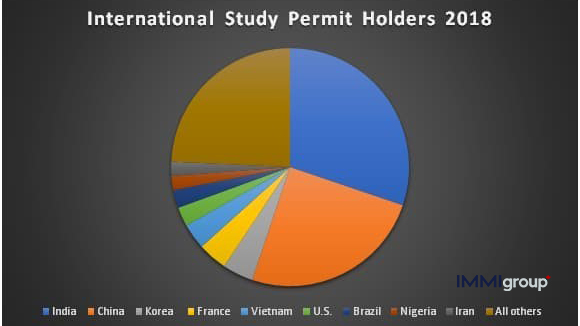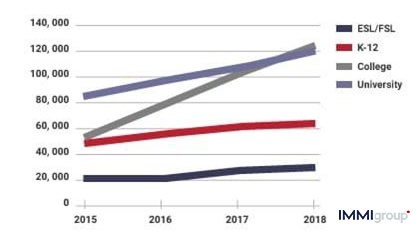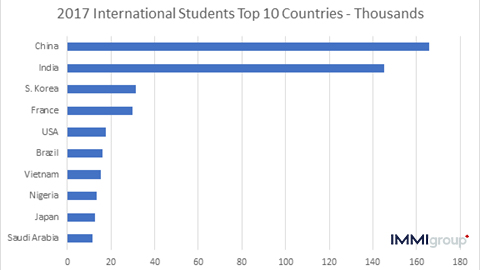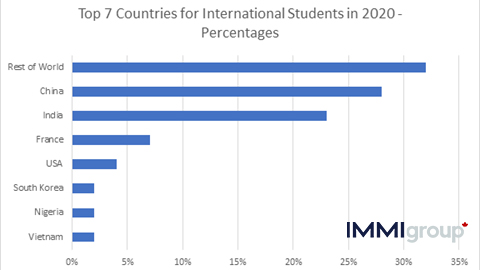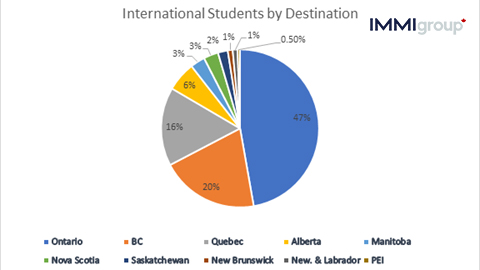International Education Strategy

Why Canada Needs You?
INTERNATIONAL EDUCATION STRATEGY (2014–2019)
This latest iteration of Canada’s international education strategy is managed by the Trade Commissioner Service of Global Affairs Canada and has several key objectives amongst its many goals:
I: MORE STUDENTS FROM MORE COUNTRIES
A key goal is to diversify the source countries for international students. Currently China and India account for over 50% of international students in Canada. Consider the following graphic:
While India and China will clearly remain important source countries for international students, the governments new strategy aims to increase the participation rate of students from other countries. As an example of an action taken towards this goal, the Student Direct Stream has recently added Senegal and Morocco as participating countries. SDS enables expedited study permit processing (usually within 3 weeks) for students who have been accepted at a Canadian post-secondary institution.
II: MORE SCHOOLS WITH MORE INTERNATIONAL STUDENTS
Another key objective is to increase government support for Canadian institutions to enable them to export their services (accept more international students) and expand their reach abroad. This means that this new strategy aims to steer more international students towards other universities and not just have them attend universities in Toronto or Vancouver, for example.
What this means is that international students will have a much wider range of universities and colleges to choose from. At IMMIgroup we’ve talked about college programs that international students should consider, and the options will only grow over time as more colleges and universities expand their abilities to engage with students from abroad. So, you don’t necessarily have to fret about getting into UBC’s medical school, or into the software engineering program at Waterloo. You’ll have a wide range of institutions to choose from.
In fact, it’s already happening. Consider this graphic:
This graph shows the number of study permits issued by year and by the level of study involved. In other words:
- ESL/FSL refers to study permits to study English or French as a 2nd language in Canada.
- K-12 refers to kindergarten through high school.
- College refers to community colleges.
- And University obviously refers to Canada’s universities.
What do you notice about this graph?
Look at colleges. The attendance at colleges in Canada on the part of international students has skyrocketed over the last 4 years, from around 50,000 to over 120,000. Colleges now account for the largest amount of study permits, just beating out universities. Clearly, international students are becoming aware of the wide range of educational options across Canada, and the government intends to provide further resources and support to encourage and broaden this trend.
But not only that, the new educational strategy wants to diversify across Canada’s various regions and provinces. Consider the following example of how international students help boost Canada’s economy and contribute to Canada’s culture.
Memorial University in St. John’s Newfoundland was the meeting place for two international students: Joseph Tao from Malaysia and Sahand Seifi from Iran. They came up with an idea for a social media company that provides a platform for streamlining workflows at agencies that use social media as a business tool (which many agencies do nowadays). What happened next?
- They secured $2.65 million in funding from investors.
- They now employ more than 30 high-tech workers.
- They are a client of the Trade Commissioner Service.
- Their name? HeyOrca Inc.
This kind of success story is precisely why the Trade Commissioner Service is leading the charge with this new strategy. A cutting-edge social media company based in Newfoundland that provides 30 people with an innovative work environment. It doesn’t get better than that. But it’s only the beginning. In fact, it’s the future for international students in Canada.
So, what else does this new strategy entail?
III: MORE CONNECTIONS AROUND THE WORLD
A 3rd goal is to increase the opportunities for Canadian students to work and study abroad, with emphasis on exchanges with countries in Asia. This can be done through a number of initiatives, including:
- Setting up and expanding youth and student exchanges with countries abroad.
- Developing educational partnerships with institutions abroad.
- Recruiting international students for enrollment in Canadian educational institutions to establish more contacts and connections with educational institutions abroad.
In other words, as an international student, you will be sought after by Canadian university/college recruiters who themselves will be competing with institutions in Australia, New Zealand, the UK, Germany, and of course, the USA. And they are going to be looking for increasing numbers of international students in Canada, given the demographics of the country.
And that means more programs and support services designed to help you settle into student life in Canada. And that includes everything from a private vocational institution to working on AI projects at University of Toronto.
Don’t limit yourself when thinking of studying in Canada. The growing diversity of opportunities will surprise you.
For example, since early 2014 when the Harper government announced Canada’s International Education Strategy: Harnessing Our Knowledge Advantage to Drive Innovation and Prosperity, Canada has been developing its International Education Strategy dedicated to branding Canada as a world class education destination.
While some may argue Canada’s universities and colleges are sometimes not-quite-world-class, it is clear that for some years now, the government has been prioritizing certain areas in education and certain countries as well. For example, as part of the same education strategy, the Globalink program, for example, is meant to encourage student mobility for talented, international students interested in research projects from the following countries to study in Canada:
- Australia
- Brazil
- China
- Colombia
- France
- Germany
- Hong Kong
- India
- Mexico
- Pakistan
- Taiwan
- Tunisia
- Ukraine
- UK
- USA
The plan is focused on research and training programs that will aid innovation and support growth in key areas of Canada’s economy. Not only that, but the goals of the education strategy also include:
- Create 86,500 new jobsin the educational sector by 2022;
- Increase international student spendingto over $16.1 billion by 2022;
- Provide a $10 billionannual boost to Canada’s economy by 2022.
In other words, the education strategy announced back in 2014 is all about the money. It seems they want international students to start spending way more on tuition in Canada, the way they do in the USA. While specialized research programs and degrees might justify this, the discriminatory fees faced by international students seems part of a deliberate strategy to put more cash in the pockets of schools and governments in Canada.
Does this mean that some international students are more welcome than others? One way of seeing if this might be true is to study the student visa processing times at visa offices in distinct countries and regions of the world. Do they line up with the countries listed above? And if not, why are there such differences?
Finally, let’s take a look at how Canada’s universities are becoming more diverse with students from around the world accounting for a greater and greater percentage of newly enrolled post-secondary students:
IV: WHO’S COMING TO SCHOOL?
According to Statista.com the top 10 source countries for international students in Canada in 2017 were:
By 2020, according to Statistics Canada, the top 7 source countries for international students were as follows:
When looking at that Rest of World figure of 32% remember that it’s divided between over 200 countries each with less than 2% and sometimes only a handful of students. Yes, there were international students from over 220 countries in Canada in 2020.
As we explain in our blog on Student Direct Stream (SDS), placing China, India, and Vietnam as priority countries for student and research exchanges makes sense given that around 50% of international students come from East Asia. Including Brazil and Mexico as priority countries seems more about trade between Canada and a NAFTA fellow member, and between Canada and an important investor and trade partner of Canada in South America. Because in terms of foreign students, Latin America and the Caribbean only account for less than 10% of the total. South Asia is well-represented with both India and Pakistan as member countries of SDS, while Nigeria and Senegal mean that Africa will become increasingly important in the future of post-secondary education for international students in Canada.
Statistics Canada also indicate that the destination of international students in Canada by province or territory in 2020 is as follows:
That means that 67% of international students end up studying at a post-secondary institution in Ontario or BC. While there are clearly a far larger number of schools in those provinces (as is the case for francophone schools in Quebec) it also means that there’s a lot more competition for spaces in places like Toronto and Vancouver. As we’ve pointed out, schools in other provinces are determined to start filling their lecture halls with bright and engaged students from around the globe to help them renew and renovate their institutions. So, while Ontario and BC will likely remain top destinations, take a look at places like Alberta, Manitoba, and the Maritime Provinces, especially Nova Scotia. You’ll be surprised at what you find.
